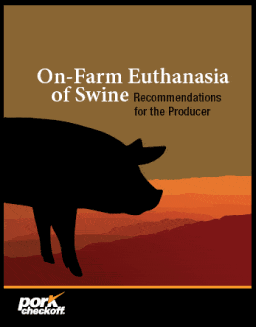AASV News
 Revised swine euthanasia guidelines published
Revised swine euthanasia guidelines published
The AASV and National Pork Board (NPB) recently reviewed and revised the document On-Farm Euthanasia of Swine – Recommendations for the Producer. The 20-page booklet is designed to help producers make appropriate decisions regarding euthanasia of swine. It highlights methods of euthanasia recommended for different sizes of pigs and outlines the factors to be considered when selecting a method for use.
The revision of the guidelines was completed by a joint AASV-NPB working group. The AASV members who served on the working group were Drs Scanlon Daniels, John Deen, Morgan Morrow, David Reeves, and Lisa Tokach. A comprehensive literature review of swine euthanasia was a key resource utilized by the group as they considered the appropriateness and humaneness of each method of euthanasia. The AASV Foundation provided funding for the literature review, which was conducted at Iowa State University.
The Pork Checkoff’s PQA Plus™ program uses the euthanasia guidelines as a training resource and encourages producers to discuss euthanasia options with their veterinarian to formulate an action plan for use on the farm. The booklet is available in electronic (pdf) format on the AASV Web site (www.aasv.org) under the “Publications” menu. Print copies may be ordered from the Pork Store at www.porkstore.pork.org/producer.
AVMA amends policy on antimicrobials in livestock feed
The AVMA House of Delegates (HOD) held its winter session in Chicago January 9-11 and considered a number of resolutions, including one submitted by a coalition of food-animal veterinary groups. The AASV joined with the bovine practitioners, avian pathologists, and small-ruminant practitioners to submit a resolution recommending changes to the AVMA’s existing policy on antimicrobial use in livestock feed.
The amended policy reinforces the need to base regulatory decisions regarding antimicrobial use on science-based risk analyses, emphasizes the important role of veterinarians in antimicrobial decisions, and recognizes the necessity of establishing a valid veterinary-client-patient relationship. The policy urges veterinarians to continually assess and critically review the uses of antimicrobials in livestock feed and recommends that veterinarians consider preventive practices to minimize the need for antimicrobials.
Dr Bill Hollis, the AASV delegate to the HOD, defended the suggested amendments by describing the process by which antimicrobial feeds are utilized in swine production. Following a brief discussion, the resolution passed by an 87% majority.
In addition to Dr Hollis, the AASV was also represented at the winter meeting by Dr Jen Greiner, HOD alternate delegate. Also attending the AVMA’s Leadership Conference from AASV were Drs Butch Baker, Paul Ruen, and Brian Payne.
Government selects Kansas for biodefense laboratory
The federal government has selected a site in Kansas for a new $450 million laboratory to study biological threats like anthrax and foot-and-mouth disease. The Department of Homeland Security’s choice of Manhattan, Kansas, beat out intense competition from other sites in Georgia, Mississippi, North Carolina, and Texas. Kansas mounted one of the most aggressive efforts to win the new laboratory, forming a special task force to lobby Homeland Security officials after Senator Pat Roberts, R-Kansas, promoted its economic potential. The new laboratory, the National Bio and Agrodefense Facility, would replace an aging 24-acre research complex on Plum Island, New York. Foot-and-mouth disease research has been confined to the island since 1955 to avoid an accidental outbreak that could lead to the slaughter of millions of livestock.
The laboratory is expected to generate about 1500 construction jobs and a permanent payroll of $25 million to $30 million for more than 300 employees, once the project is completed by 2015.
AASV launches e-mail discussion list
In response to a suggestion from the AASV Board of Directors during their fall meeting, the AASV launched an e-mail discussion group, AASV-L, for the association’s members on Thursday, January 15.
All AASV members are automatically subscribed to the discussion group with the opportunity to opt out if an individual chooses to not participate. An introductory posting was distributed on January 15 announcing the launch and encouraging members to participate. The purpose of AASV-L is to provide a forum for AASV members to interact with colleagues to discuss issues of interest.
E-mail discussion groups offer an opportunity to reach out to all subscribers to promote a broad range of responses to issues posted. Anyone subscribed to the group can submit a posting. The post is reviewed by the moderator to verify its appropriateness before being distributed to all subscribers. Subscribers can then submit replies creating a thread of postings and replies on a specific topic.
AASV-L can serve as a rapid and efficient method to disseminate information, but will be only as successful as the level of participation by the membership. Please take a moment to try out the system and enjoy the exchange. We hope you will find this to be a useful tool and will submit topics for discussion and reply to those that interest you.
